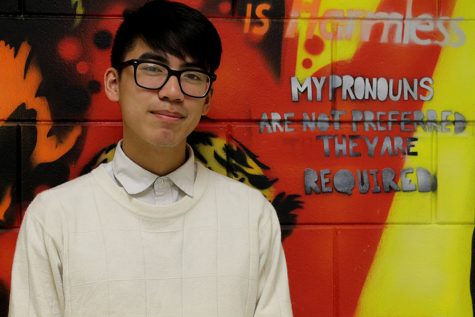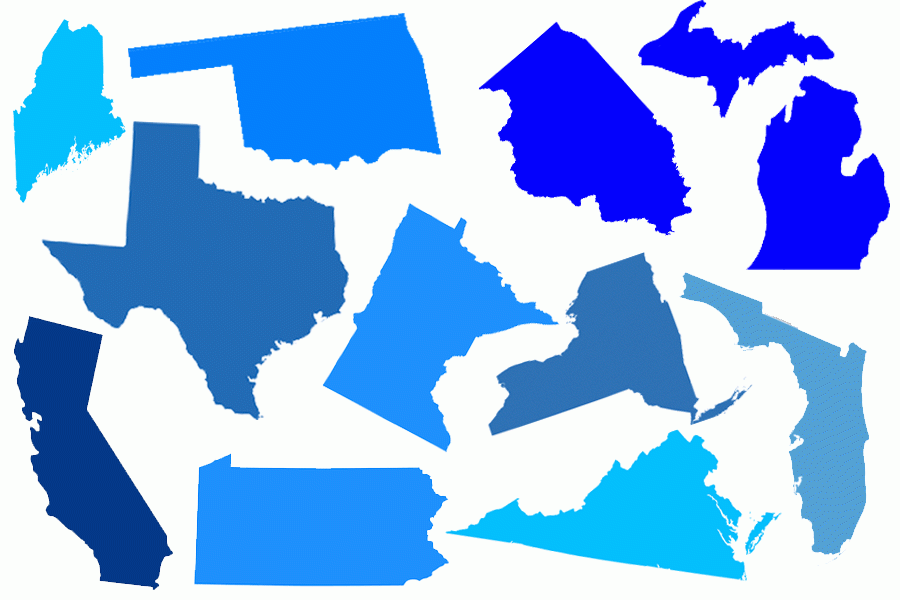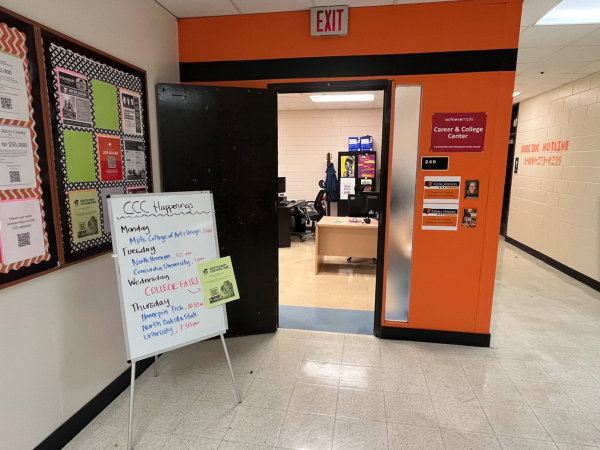The “blue wave”: what then, what now, and what next?
Many states had House and Senate seats flipped. “It was a big day for progressive politics in Minneapolis, in Hennepin County, in America,” said State Representative Aisha Gomez. With a House majority, Democrats can now use checks and balances in the legislative branch against the Trump administration.
On November 6, 2018, the midterm elections took place, marking several key races at every position and level of government throughout the United States. Being the first midterm elections since the inauguration of Donald Trump as president, Democrats have fiercely mounted many campaigns that have been received as successful in more ways than one, whether it be flipping a seat, shifting political norms, or magnifying crucial issues affecting our country.
Although this December marks only a month since the midterm elections, the work of political organizers, activists, and elected officials continues to be felt within our reflections of present-day America and what progressives hope to reclaim from the changes of the Trump administration. As our country usher in Liberals and progressives into office, what can we hope to see change?
“The 2018 were the first ‘meaningful’ elections post-Trump, which meant Democrats expected a huge reactionary blue wave to roll out,” South High senior Marie Stebbings said.
“Local elections take on greater import when you have levels of government that are threatening people’s lives and well-beings,” said Aisha Gomez, a South High alumni who became State Representative for 62B in this year’s elections. “It becomes much more important to have folks in office at city, county, state levels who are willing to do the work to fight back against that.”
“Obviously [Democrats] won Congress back, [Democrats] won the House back,” Gomez continued. “It was a big day for progressive politics in Minneapolis, in Hennepin County, in America.”
Gomez is referring to what political analysts are calling the “blue wave.” After the Democrats acquired a net gain of 39 seats, 100 women now occupy seats in the House of Representatives, which beats the previous record of 85 according to the Congressional Research Service.
“This was a historic election,” South High social studies teacher Doug Berglund said. “[39 seats] is a historic high, even though the Republicans did win some seats.”
In addition, we might be bearing witness to the most diverse Congress in history: Sharice Davids and Deb Haaland are the first Indigenous women in Congress. Ilhan Omar and Rashida Tlaib are the first Muslim women in Congress. Jared Polis is the first openly-gay governor. For Democrats, the list of firsts continues on.
“I think we did see … some really meaningful campaigns—notably Alexandria Ocasio-Cortez, Ilhan Omar, Deb Haaland, and many, many others—that really inspired hope among voters and spoke to the young and marginalized people of America in ways that previous campaigns have failed to do,” Stebbings said.
Although the historic elections of, say, Ilhan Omar and Rashida Tlaib are substantial feats alone in terms of advancing the diversity of the House, the Democrats seem to be celebrating a much bigger victory: flipping the House. For Democrats, winning over the House is a total greater than the sum of the new Democrats occupying its seats.
With a House majority, Democrats can now use checks and balances in the legislative branch against the Trump administration.
Berglund gave a long, exhaustive list of checks and balances for the Democrats: “They could vote to override any veto he does,” he began. “They could initiate their own searches for government misconducts … They can delay or dismiss any bills that he wants to pass.”
The biggest check on the table as of now is impeachment. With a democratic majority, the House of Representatives could initiate the process of impeachment against Trump, which alleges specific charges against the elected official in question. Many Democrats, ever since the inauguration of Trump, have expressed consideration for impeachment process.
With a government that many see as a more accurate reflection of the people whom our elected officials serve—in addition to the newfound capabilities of a flipped House—2018 might be a keystone election towards the fulfillment of progressive agendas on all levels of government.
Although the future for Democrats seems to be proudly marked by the historic elections of Ilhan Omar and Sharice Davids, Democrats still feel unsteady. Despite these victories, the fight does not seem to be over; to many, there’s still a long, twisted road for Democrats to navigate, especially in wake of Trump’s historic election in 2016.
“After 2016, there was a lot of this energy,” Ashley Fairbanks—a South alumni and the Digital Director for the Ilhan Omar campaign—said. “I think what 2016 was missing was someone who was actually inspiring people to do something.”
During this year’s elections, many organized with the specter of the 2016 election looming closely behind. As much as the midterm elections were motivated by a desire to right the wrongs of the democratic party, the midterm elections also illustrated how there was still salt in the wound from previous failures.
“Most of the Democratic campaigns run in 2018 weren’t radically different from those run in 2016 or 2014, with a few notable exceptions,” Stebbings said.
“Despite the gains we made, we could have made a lot more if we had effective organizing strategies across the board from local seats all the way to the national level,” Fairbanks continued. “We’ve done a lot of things wrong on the progressive movement and haven’t built power in the right ways.”
Fairbanks gave a few examples of where Democrats went wrong: “We continue to run centrist people and moderate our messaging when we know that those things don’t work and that the middle doesn’t really exist anymore,” Fairbanks said.
“Are we seeing an increasing recognition of some of the systemic problems that underwrite America? Sure.” Stebbings said, with a catch. “Are we seeing any meaningful, material change in terms of the implementation of those politics? Not really.”
Progressives in Minnesota were deeply unhappy with Tim Walz—a moderate—winning the primary over Erin Murphy—a progressive. Murphy’s loss, to local Democrats, signaled that Democrats still remain trapped within a hard place that struggles to encourage progressive change and support progressive candidacies.
Instead, Democrats are torn between preaching to the choir with mixed messages and empty promises and creating bold policy agendas that change the status quo. In wake of an administration that has challenged everything that the Democrats have built up to this point.
“We need to be cautious about overstating the potential of these ‘progressive candidates,” Stebbings warned. “As they symbolize a very, very tiny part of a larger movement that needs to happen.”
“Like Beto [O’Rourke],” Fairbanks gave as an example: “People weren’t excited because he was a moderate saying all the right keywords, they were excited because he had a personality and a message.”
This year, candidates like Andrew Gillum, Angela Conley, and Deb Haaland seemed to have ignited a resurgence on all levels of government for progressive movements—and an excitement for political change—within the Democratic party.
“They signal that a politics of hope is the most important message a campaign can have,” Stebbings remarked. “And that people are tired of hearing the same old moderate s***.”
Although they were cut short by close races, Fairbanks hopes that we can see that energy again in 2020: “People are actually ready for progressive change,” she said. “But we can’t win if we’re not actually proposing anything different.”
“I’m hopeful that we won’t compromise and not skew towards the middle when we’re talking about our battle for the presidency,” Gomez agreed. “What got missed was this deep sense that this economy is unfair … It’s not working for most of us.”
Gomez and Fairbanks both saw that energy working alongside Hennepin County Commissioner Angela Conley and Congresswoman Ilhan Omar, two women of color who won historic elections this year by exposing long-standing structural inequities, promoting love in their communities, and pushing forward a set of unflinching demands that refused to negotiate with the problems of the present.
“We have to have bold messages around [change] and not just, ‘Let’s do whatever the f*** Wall Street wants us to do,’ which is what Democrats have been doing for the past 20, 30 years,” Gomez concluded.
Are the 2018 midterm elections a keystone for the Democratic party, or simply another entrenchment of a self-fulfilling prophecy that has constantly lagged Democrats behind?
In today’s America’s unpredictable politics shifted by a post-Trump era, only time will tell how the ongoing battle for progress in America fares under a Democratic party struggling to solidify its demands and realize its true direction in wake of new challenges from the Right.

Senior B Fei, a Staff Writer on the newspaper since the beginning of this school year, can be found sporting a myriad of sweaters and wearing their signature...











